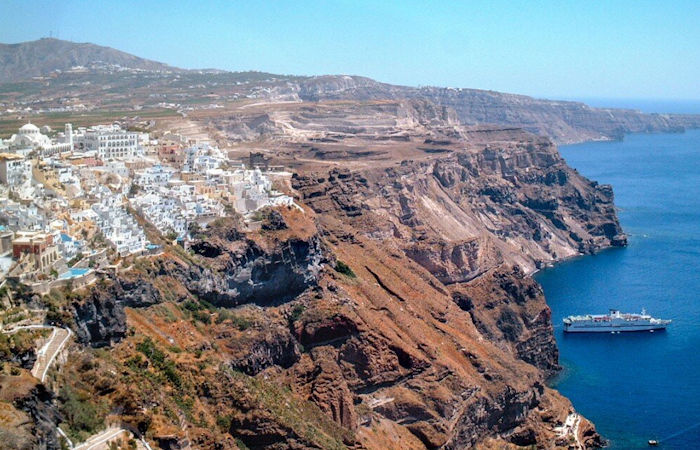Jan Bartek – AncientPages.com – One of the largest volcanic eruptions in the Holocene epoch—as measured by the volume of material ejected—occurred on the Greek island of Santorini, traditionally known as Thera. It is considered a pivotal event in the prehistory of the Aegean and East Mediterranean region, with the city of Akrotiri, buried some 1,600 years before Pompeii, becoming one of the key archaeological sites of the second millennium BCE. That much is uncontested.

The Greek island of Santorini, traditionally known as Thera, experienced one of the largest volcanic eruptions in the Holocene epoch, most likely between 1609 and 1560 BCE, according to a new analysis by Sturt Manning, Distinguished Professor of Arts and Sciences in Classical Archaeology. Credit: Sturt W. Manning
Archaeologists in the early 20th century posited the volcano erupted around 1500 BCE, during the Egyptian New Kingdom period, and created a history around this ᴀssumption. But beginning in the 1970s, advances in radiocarbon dating have thrown that timeline into chaos, with many experts insisting the eruption happened as much as 100-plus years earlier.
Sturt Manning, Distinguished Professor of Arts and Sciences in Classical Archaeology in the College of Arts and Sciences, is hoping to settle one of modern archaeology’s longstanding disputes. By parsing the available data and combining it with cutting-edge statistical analysis, he has zeroed in on a much narrower range of dates for the eruption: approximately 1609–1560 BCE, during the preceding Second Intermediate Period of Egypt, when the Hyksos—a Canaanite-origin dynasty—controlled Lower Egypt. While not yet a precise date, to the year, for resolving the big-picture question of the correct historical period, the finding clarifies many years of debate.
Manning’s paper, “Second Intermediate Period Date for the Thera (Santorini) Eruption and Historical Implications,” published Sept. 20 in PLOS ONE.
“This has been the single most contested date in Mediterranean history for over 40 years,” said Manning, who directs the Cornell Tree-Ring Laboratory. “It’s been one of these endless disputes, to the point where people just say, ‘there’s a problem here, we can’t solve it, let’s move on.’ I’m hoping with this paper people may suddenly go, ‘You know what, this actually limits and defines the problem in a way that we’ve never been able to do before, and narrows it down to where, usefully, we can say it’s in the Second Intermediate Period. So we should start writing a different history.'”
For Manning, the Thera eruption has been like Mount Everest—a challenge that he has wanted to tackle since early in his career. Accurately dating the event has become more feasible in recent years with the increased sophistication of Bayesian statistical analysis, enabling chronological modeling that can integrate mᴀssive amounts of data and archaeological observations to better define the probability parameters for an unknown event.
The parameters have been fairly well understood for years, Manning said, thanks to the extensive geological and archaeological research that’s been conducted. The missing piece of the puzzle has been an often-raised concern that volcanic carbon dioxide emissions could have contaminated organic samples from Thera and caused incorrect age ᴀssessments.
Last spring, Manning realized he could solve the problem by looking elsewhere—hundreds of kilometers away from Thera—to regions of the Aegean Sea that experienced the tsunami effects caused by the eruption. Manning incorporated dates obtained for these episodes into his model to test for, and discount, the volcanic carbon dioxide caveat. On Thera itself, he also spotted the importance of a short but clearly observed gap in time between the abandonment of the town at Akrotiri and the huge eruption, and he incorporated this previously overlooked constraint into the modeling.
“It’s been observed for years that there is some short interval in the archaeological sequence between when the city of Akrotiri was abandoned by its human population and before its burial under meters of pumice from the eruption. Even though several hectares have been excavated, no human skeletons have been found, so clearly people had warning of impending peril and left. No one’s allowed for that in the past,” Manning said. “By putting that extra qualification in, we тιԍнтen the statistical analysis.”
The modeling identified the most likely range of dates for the eruption to be: between about 1609–1560 BCE (95.4% probability), or about 1606–1589 BCE (68.3% probability).
The new timeline synchronizes the civilizations of the eastern Mediterranean while also ruling out several ancillary theories, such as the idea that the Thera eruption was responsible for destroying Minoan palaces on the coast of Crete as the first excavator of Akrotiri, Spyridon Marinatos, proposed in 1939.
“That seems not to be the case,” Manning said. “Because when we date the destruction levels on Crete, they seem to be upwards of a century later.”
Because his analysis pegs the Thera eruption earlier than the original proposed date, but not as early as radiocarbon dating had initially suggested, Manning hopes the new timeline may be more palatable for experts on both sides of the long-running debate.
See also: More Archaeology News
“This demonstrates, as with so much of science, that people have to make hypotheses based on the initial information, but as you get more and more information and better analysis, you revise and refine,” he said. “In this case, the answer seems to be between the original position and the first radiocarbon indications pointing as much as 100-150 years earlier. Hopefully this new analysis, based on a large dataset and a recent, better-defined radiocarbon calibration curve released in 2020, should be more palatable for the overall archaeological and historical fields. It changes the historical context, but at the same time, is not trying to push things quite so far out of the envelope.”
The study was published in the journal Plos One
Written by Jan Bartek – AncientPages.com Staff Writer





